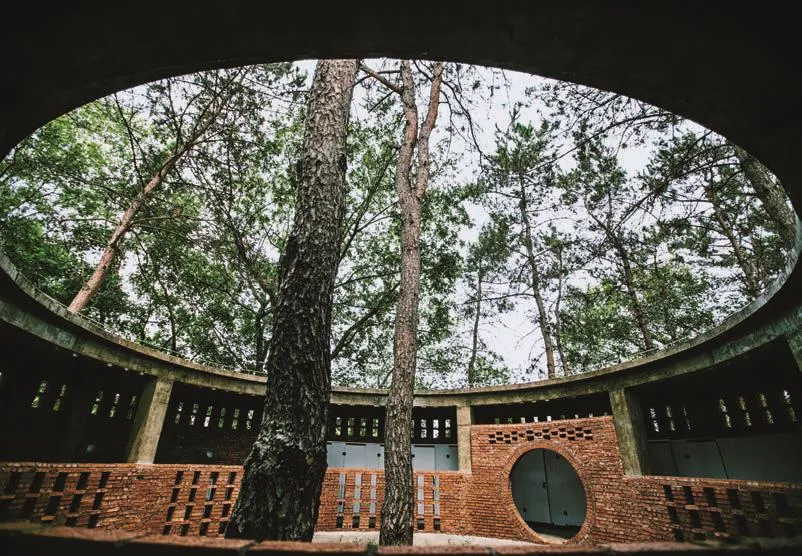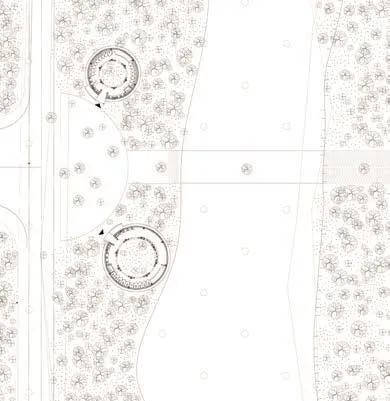澴河环厕,孝昌,中国
2019-07-01李涛,ZHANGLiuyang

1 外景/Exterior view
限制的风景才是美景。建筑除了功能使用,还能带给人美好的感觉;解决生理问题的建筑,也能带来心理上的美好感受。
这个公厕项目位于湖北孝昌澴河边,场地所在地花园镇为了举办龙舟节大赛,要对场地现有周边环境进行改造提升,包括新建广场、栈道、公厕、码头平台等。
现场多年生的松树,密集高大,场地原来有一个农村常见的简易旱厕,卫生状况堪忧。建筑师在构思初期,将保留松树作为第一选择,根据实测的场地树木布置位置,设计了两个半径大小不同的环形建筑,巧妙地绕开了所有松树。
这贴合建筑师一直坚持的“建筑和景观一体化”实践理念:在这个项目中,建筑与植物的相互交融,使得建筑仿佛已存在于场地很多年;而建筑成为松树的载体,松树林将建筑包围。这是以景观师的思维模式在思考建筑设计:建筑如同植物放大的容器,将植物等自然要素放在建筑等人工要素之前。
圆形建筑的布局,男女两个公厕分列于入口广场两边,女厕稍小,男厕稍大。
松树林遮天蔽日,在顶部形成了建筑的第二层“大屋顶”,这让松树下室外和室内的界线变得模糊。环形建筑内院这种感觉尤其强烈,环形的清水混凝土顶带给人只是屋檐的感觉,而松树带给人第二层自然屋顶的感觉。圆形内院把人的视线引上天空,因为有了圆形的画框,松树这种再普通不过的树木,变成了一幅生动的画。
环形内院的气氛,更使人在上厕所的过程中有了一种放松。从外面的松树天空,过渡到内院被圆形裁剪过的天空,给人一种心理暗示:你是在室外上厕所,但你的隐私却是得到保证的。这满足一般人想在室外上厕所的冲动,又把最好的风景送到你的眼前。上厕所的人,还有一个行为模式是沿着环形走廊走一圈才会离开。1.2m高半遮挡的环形花格子墙,满足了这种探知和好奇的心理。选择环形建筑内院的原因,也是考虑到公厕的通风实际功能,尽可能地增加开口面积,实现自然通风换气。
圆筒这样规则几何外观的形体,在树木自然散布状态的松林中只出现了两个。因为这种纯粹几何感,它与自然保持了适当的距离,又有辨识度。圆形是设计师人为刻意的结果,被用在这个简单项目上来验证尺度和空间的关系,为将来的其他项目提供了原型的探索。
为了保证几何体量的纯粹性,建筑材料其内墙、外墙都选择了清水红砖墙;这个也是考虑到当地施工队的工艺水平,保证项目施工有一定容错性。事实证明这个选择是对的,在赶工期阶段,内墙就不需要贴瓷砖,地面也用小青砖围绕环形做弧度铺设,它耐脏、吸水,也符合郊野公厕的卫生管理粗放的实际需求。所有的混凝土浇筑后,只刷了清漆处理,这也是建筑师在过去的项目中试验总结出的保护清水混凝土的土办法。
男女厕的外墙上的标志,用红砖砌筑突出墙面的“凸凹”两字,算是建筑师开的一个小小的玩笑,其实也是结合砖本身的材质砌筑特性而来的方案。红砖的砌筑特性还体现在留孔的花格式砌法,容易创造出多变的光影,结合圆形洞口的光影使这个环形厕所在一天的阳光变化下,投影不断发生变化,带来了戏剧般的空间效果。在清水红砖墙的立面,穿插砌筑了玻璃砖。在夜晚,公厕变得具有标示性,这一日常的公共建筑变得浪漫了。□(李涛 文)
项目信息/Credits and Data
主持建筑师/Principal Architect: 李涛/LI Tao
设计团队/Design Team: 李龙,陆洲,申剑侠,董昊,祖丽君/LI Long, LU Zhou, SHEN Jianxia, DONG Hao, ZU Lijun
材料/Materials: 红砖,混凝土/Bricks, concrete
建筑面积/Floor Area: 198m2
造价/Cost: 25万人民币/250,000 CNY
设计时间/Design Time: 2017
竣工时间/Completion Time: 2017
摄影/Photos: 李涛,李梦琳,申剑侠(航拍部分)/LI Tao, LI Menglin, SHEN Jianxia (aerial part)

2 鸟瞰/Aerial view

3 内景/Interior view

4 鸟瞰/Aerial view

5 内景/Interior view
A limited scenery is the true beautiful scenery.Architecture can bring the beautiful feeling in addition to function, which can solve physiological problems and breed wonderful psychological feelings.
The public toilets project is located near Huan river, Huayuan Town, Xiaochang City, Hubei Province. In order to hold the Dragon Boat Festival Competition, the existing surrounding environment of this site should be upgraded, including new square, Boardwalk, public toilet, wharf platform, etc.
There are large expanses of perennial pine trees on the original site, but only one dry latrine with poor sanitation condition, which is common in Chinese rural areas. The architect decided to take preserving these pine trees as the first choice.Thus, two annular buildings of different sizes were designed, and all the pine trees were skillfully bypassed according to the measured location of these pine trees. This perfectly fits in the concept of "blending of architecture and landscape" that the architect has always insisted on. In this project,the integration of architecture and plants makes these two buildings seem to exist on the site for many years. The buildings are regarded as two large containers of the pine trees, and the pine forest surrounds them. Natural elements such as plants takes precedence, followed by artificial elements such as construction. This is how the architect uses the mode of thinking landscape to design buildings.
The building has a circular layout with men and women's public toilets arranged on both sides of the entrance square. The women's toilets are slightly smaller than the men's room .
Covering the sun, the pine forest forms a second "roof" of the building and all the activities are guided under the pine trees, which makes the boundary between the outdoors and indoor blurred.This feeling is particularly strong when people are in the building. The round inner courtyard directs view sight to the sky, and the shape of it makes it a perfect circular frame, which makes these common pine trees a vivid picture.
From the outside sky filled with the pine trees to the rounded sky cut by the circular inner courtyard,this courtyard builds an interesting atmosphere,which makes people feel relax during using toilets.It gives people a psychological hint: they are in the outdoor toilet, but their privacy is still guaranteed.This will satisfy the impulse of most people who want to go to toilets outdoors, while seeing the best scenery. There is another behavior pattern of these people which is, they intend to will walk around the corridor before leaving. This 1.2-metre-high wall with semi-blocked-flower lattice meet their psychological needs of exploration and curiosity. The reason for the shape of the courtyard is that the actual function of the toilets was taken into account. The architect try to increase opening area and to achieve natural ventilation as much as possible.
There only two cylinders, the regular geometries,in the pine forest. Pure geometry brings it self recognition while it keeps a proper distance from nature. This geometry is designed intentional by the architect, who regards this project as an experiment to verify the sense of scale and spatial sense of the"round" building, as well as to provide a prototype exploration for other projects in the future.
The architect chose red brick as the building material in order to ensure the purity of the geometric volume and error tolerance considering construction technology of local building workers.It is proved to be right eventually: walls will not need to be decorated with tiles on the deadline; dirt resistance and water absorption of it makes it easy to manage after being put into use. All concrete was varnished after being cast.
The logo, "concave-convex" in Chinese, of men's toilets and women's on the external wall was also made by red brick and the idea of it was inspire by the characteristics of brick. These special characteristics of it are also used to build holes like flower puzzle,in order to create variable light and shadows, which creates dramatic and dynamic space effect combined with shadow of circular inner courtyard. Glass bricks were also used intermixed in the external wall to make these two building more significant and romantic. □ (Translated by ZHANG Liuyang)

6 总平面/Site plan

7 男厕所平面/Plan of men's toilet

8 女厕所平面/Plan of women's toilet
评论
钟惠城:用圆环作为厕所的空间形式是有趣的,但纯粹的形体,尤其是圆形,对人的行为和心理有着很大的影响,当这个空间被用作厕所时,关系就更复杂了。因此,我很好奇,实际的如厕体验与空间在心理上会建立怎样的联系?遗憾未能看到更多建筑内部的照片,只能通过平面图去想象了。
Comments
ZHONG Huicheng: It is interesting that architect uses a ring as form of the toilet, pure shape, especially circle, brings huge impact to people's behavior and mentality, it is even more complicated when this space is used as a restroom. Therefore, I am curious about the mental relationship between the toilet experience and the space. It is regret that I could not see more interior photos of the building, I have to imagine based on the plan.
彭小松:该项目积极回应乡村建设的实际条件,以在地工艺打造品质生活,用纯粹的几何空间切合生态微观环境。简洁的建筑形体形成了有仪式感的空间序列,内外意向各有千秋;对场地内松树植被的谨慎考量与避让,使得厕所建筑能够完美结合并融入到周边环境中,成为公共生活的美丽背景和有力支撑。同时,设计体现出对砌体结构及其纹理的把控,并能有针对性地利用和引导周边景观,以影响内部环形区域的空间体验,形成特别而富于诗意的建构表达。(肖靖 校)
PENG Xiaosong: The project responds to the actual conditions of rural construction with a positive attitude. It creates life styles with qualities by using local crafts and ecological microenvironment in form of pure geometry. The simple architectural forms render a spatial sequence of ritual, marrying both internal and external intentions. After carefully considering the possibility of not interfering with pines in the site, it perfectly integrates the toilet with surroundings and then provides a beautiful and supportive backdrop for public life. At the same time, the design masters the masonry structure and texture, and strategically takes advantage of and conducts the surrounding landscape into the spatial experience of the inner circle. It represents a unique and poetic expression of tectonics.(Translated by HAN Li, proofread by XIAO Jing)
